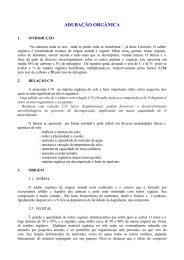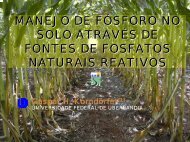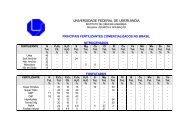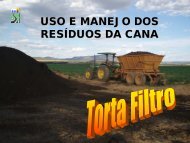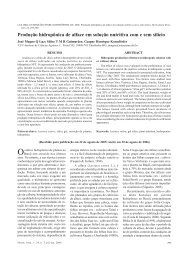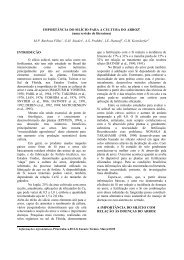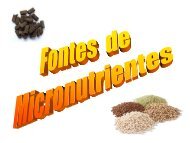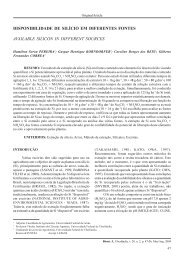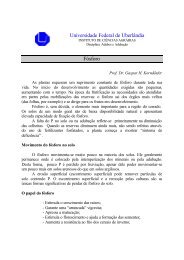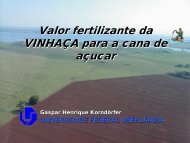Journal of Plant Nutrition - Professor Gaspar Henrique Korndorfer
Journal of Plant Nutrition - Professor Gaspar Henrique Korndorfer
Journal of Plant Nutrition - Professor Gaspar Henrique Korndorfer
- No tags were found...
Create successful ePaper yourself
Turn your PDF publications into a flip-book with our unique Google optimized e-Paper software.
This article was downloaded by:[Buck, Guilherme Bossi]On: 19 February 2008Access Details: [subscription number 790548861]Publisher: Taylor & FrancisInforma Ltd Registered in England and Wales Registered Number: 1072954Registered <strong>of</strong>fice: Mortimer House, 37-41 Mortimer Street, London W1T 3JH, UK<strong>Journal</strong> <strong>of</strong> <strong>Plant</strong> <strong>Nutrition</strong>Publication details, including instructions for authors and subscription information:http://www.informaworld.com/smpp/title~content=t713597277Potassium Silicate as Foliar Spray and Rice BlastControlGuilherme Bossi Buck a ; <strong>Gaspar</strong> <strong>Henrique</strong> Korndörfer a ; Antonio Nolla a ; LísiasCoelho aa GPSi ICIAG/UFU, Uberlândia, MG, BrazilOnline Publication Date: 01 February 2008To cite this Article: Buck, Guilherme Bossi, Korndörfer, <strong>Gaspar</strong> <strong>Henrique</strong>, Nolla,Antonio and Coelho, Lísias (2008) 'Potassium Silicate as Foliar Spray and Rice BlastControl', <strong>Journal</strong> <strong>of</strong> <strong>Plant</strong> <strong>Nutrition</strong>, 31:2, 231 - 237To link to this article: DOI: 10.1080/01904160701853704URL: http://dx.doi.org/10.1080/01904160701853704PLEASE SCROLL DOWN FOR ARTICLEFull terms and conditions <strong>of</strong> use: http://www.informaworld.com/terms-and-conditions-<strong>of</strong>-access.pdfThis article maybe used for research, teaching and private study purposes. Any substantial or systematic reproduction,re-distribution, re-selling, loan or sub-licensing, systematic supply or distribution in any form to anyone is expresslyforbidden.The publisher does not give any warranty express or implied or make any representation that the contents will becomplete or accurate or up to date. The accuracy <strong>of</strong> any instructions, formulae and drug doses should beindependently verified with primary sources. The publisher shall not be liable for any loss, actions, claims, proceedings,demand or costs or damages whatsoever or howsoever caused arising directly or indirectly in connection with orarising out <strong>of</strong> the use <strong>of</strong> this material.
Downloaded By: [Buck, Guilherme Bossi] At: 01:16 19 February 2008<strong>Journal</strong> <strong>of</strong> <strong>Plant</strong> <strong>Nutrition</strong>, 31: 231–237, 2008Copyright © Taylor & Francis Group, LLCISSN: 0190-4167 print / 1532-4087 onlineDOI: 10.1080/01904160701853704Potassium Silicate as Foliar Spray and RiceBlast ControlGuilherme Bossi Buck, <strong>Gaspar</strong> <strong>Henrique</strong> Korndörfer, Antonio Nolla,and Lísias CoelhoGPSi ICIAG/UFU, Uberlândia (MG), BrazilABSTRACTSilicon (Si) is known as a “beneficial element” for plants. The direct and indirect benefits<strong>of</strong> the element for crops (especially grasses) are related to resistance to diseases, pests,and drought. Since most studies were done with fertilizers applied to the soil, new studieson the efficacy <strong>of</strong> silicon absorption through the leaves are required. The effect <strong>of</strong> siliconabsorption through the leaves on rice blast (Pyricularia oryzae) control was studied usingpotassium silicate (K 2 SiO 3 )indifferent doses (0, 1, 2, 4, 8, or 16 g L −1 Si), number <strong>of</strong>sprayings at two solution pHs. Rice (Oryza sativa), cultivar ‘Metica 1’ (susceptible toblast), was grown in pots in a completely randomized experimental design. Silicate wasapplied beginning at the 22nd day after emergence (DAE). The pathogen was inoculatedon the 25th DAE. Disease incidence was evaluated ten days after inoculation. Potassiumsilicate pulverization on the leaves did not increase Si absorption or accumulation bythe plant; however, there was a reduction on blast incidence. The greatest reduction onblast incidence was observed at 4gSiL −1 ,regardless <strong>of</strong> solution pH.Keywords: foliar fertilization, leaf silicon, fungINTRODUCTIONSilicon (Si) has been considered as a beneficial nutrient (Raij et al., 1973) for avast number <strong>of</strong> plants, especially grasses. Usually, silicon’s effect is related tothe control <strong>of</strong> pests and diseases and improving plants’ resistance mechanisms.The effects on yield are related to physical mechanisms <strong>of</strong> defense by theReceived 27 November 2006; accepted 15 April 2007.Address correspondence to Guilherme Bossi Buck, GPSi ICIAG/UFU, Caixa Postal593 Bairro: Umuarama CEP 38400-902, Uberlândia (MG), Brazil. E-mail: gbbuck@yahoo.com.br231
232 G. B. Buck et al.Downloaded By: [Buck, Guilherme Bossi] At: 01:16 19 February 2008deposition <strong>of</strong> the element under the leaf epidermis, inducing the production <strong>of</strong>phenols, which stimulates phytoalexin production, decreases lodging, reducestranspiration, and increases photosynthesis capacity, among others (Korndörferet al., 2004).Recent research is being done on supplying Si through the leaves andon viable fertilization alternatives for this nutrient, using lower amounts thatwould provide the needed Si or else stimulate its beneficial effects. Thus, theadvantages <strong>of</strong> this technique should be explored, such as the smaller fertilizeruse (since foliar fertilization consists on supplying small amounts <strong>of</strong> nutrientsdirected to the leaves), lower cost, ease <strong>of</strong> application, good quality <strong>of</strong> fertilizersused (no contaminants), and fertilizers readily soluble in water.The importance <strong>of</strong> Si on plant nutrition is still greater in the case <strong>of</strong> organicfarming, since the use <strong>of</strong> biocides (insecticide, fungicides, nematicides, etc.)is forbidden for pest and disease control. In this case, supplying Si throughfertilization can contribute for the increase in production and protection <strong>of</strong>organically grown crops. Epstein (2001) cited some scientifically proven examples<strong>of</strong> beneficial effects that Si promotes in the plants, such as: resistanceto plant pathogen attack, better structure <strong>of</strong> plant architecture, resistance to herbivory<strong>of</strong> insects, mitigation <strong>of</strong> heavy metal phytotoxicity, greater tolerance tosoil salinity, reduction <strong>of</strong> the effects <strong>of</strong> draught, protection against extreme temperatures,promotion <strong>of</strong> symbiotic nodulation in legumes, effects on enzymeactivity and, in general, on plant mineral composition.The objective <strong>of</strong> this study was to evaluate Si absorption through the leaveson the control <strong>of</strong> rice blast caused by Pyricularia oryzae.MATERIALS AND METHODSThe experiment was done in a greenhouse (protected environment), at theUniversidade Federal de Uberlândia, Uberlândia, MG. The soil used was anUstoxic Quartzipsamment collected in Santa Vitória county, state <strong>of</strong> MinasGerais, Brazil, in a native forest formation, and its chemical characterizationis described in Table 1. This soil was selected due to its low concentration <strong>of</strong>available silicon (sandy texture) and, consequently, greater probability <strong>of</strong> plantresponse to any application <strong>of</strong> that element. The statistical design was completelyrandomized with 9 treatments and 5 replications. The treatments were:0, 1, 2, 4, 8, or 16 g L −1 Si at pH 10.5 and 0, 2, 4, or8gL −1 Si at pH 5.5, sprayed20 days after seedling emergence (DAE). The silicon source used was potassiumsilicate, containing 26% SiO 2 and a density <strong>of</strong> 1.38. The soil was amendedwith the fertilizers according to a regional recommendation for rice, except forpotassium (K), which was supplied in excess to isolate the variable K, whichwas also supplied as a foliar spray due to the silicon source used. Rice cultivar‘Metica-I,’ susceptible Pirycularia oryzae, was used. Fifteen-plants were keptin 10-kg pots until after inoculation and disease evaluation. The number <strong>of</strong>
Potassium Silicate as Foliar Spray and Rice Blast Control 233Downloaded By: [Buck, Guilherme Bossi] At: 01:16 19 February 2008Table 1Chemical characterization <strong>of</strong> the Ustoxic Quartzipsamment soil used in the experimentpH (H 2 O) Ca Mg Al P K H+Al CEC B.S. m O.M. Si1:2.5 cmol c dm −3 mg. dm −3 cmol c dm −3 % g kg −1 mg kg −14.6 0.1 0.1 0.7 1.3 19 4.5 4.77 5 74 17 0.6Ca, Mg, Al = (extractor − KCl 1 N); P, K = (extractor − HCl 0.05 N + H 2 SO 40.025 N); H+Al = potential acidity (extractor – Calcium acetate); T = CTC pH 7; V=Base saturation; MO = (Walkley-Black); Si = (extractor – CaCl 2 0.01 mol L −1 ). CEC= cation exchange capacity; B.S. = base saturation; m = aluminum saturation; O.M. =organic matter.plants per pot was reduced to 8 after disease evaluation, until the end <strong>of</strong> the experiment.The pathogen (Pirycularia oryzae)was inoculated 25 DAE, using anatomizer model Devilbis (Devilbis, #15, Allegan, MI) at a constant pressure <strong>of</strong>6lbin −1 and similar spraying time for each repetition, with a spore suspension<strong>of</strong> 3 × 10 5 spores per milliliter. The plants were kept in a dew chamber for 24hours. Percent blast incidence <strong>of</strong> rice leaves, leaf Si contents (g kg −1 ), Si accumulatedin the aboveground matter (g kg −1 ), aboveground dry matter (g), andrice panicle mass (g) were evaluated. The data were submitted to polynomialregression analysis.RESULTS AND DISCUSSIONThe results showed a significant decrease on blast incidence as Si doses increased.Blast incidence varied from 51% in the control (no Si applied) to 26%at 16 g L −1 Si (Figure 1). The effect <strong>of</strong> blast decrease was observed in treatmentswith solution pH 5.5 as well as with pH 10.5 (Figure 1), i.e., there was no effect<strong>of</strong> solution pH. Similar results were observed by Bowen et al. (1992), whostated that the major mechanism for reduction <strong>of</strong> mildew on grapes was a directeffect <strong>of</strong> foliar Si hindering the development <strong>of</strong> the pathogen, thus affecting itspropagation.Research done in organic soils in southern Florida (USA), demonstratedthat Si fertilization on rice reduced blast incidence 17 to 31% and helmintosporiosis15 to 32% in relation to a non-fertilized control (Datn<strong>of</strong>f et al., 1991).Therefore, Si fertilization can reduce or eliminate fungicide spraying in a culture,depending on disease severity.Studies relating powdery mildew reduction with foliar Si fertilization weredone on cucumber, melon, and eggplant by Menzies et al. (1992). Accordingto these authors, leaf spraying with potassium silicate reduced the number <strong>of</strong>fungus colonies on the leaves. Studies on X-ray diffraction <strong>of</strong> potassium silicate
234 G. B. Buck et al.Downloaded By: [Buck, Guilherme Bossi] At: 01:16 19 February 2008Figure 1. Effect <strong>of</strong> Si doses applied on the leaves (solution pH 5.5 and 10.5) on blastincidence (caused by Pyricularia oryzae) 10days after inoculation.showed a hindering <strong>of</strong> fungal proliferation. This indicated that potassium silicatecould have exerted a suppressing effect on the pathogen, on the leaf surface.Gama et al. (2004), studying the effect <strong>of</strong> Si fertilization via soil or leafon cotton diseases, found similar results to those presented in Figure 1, sincegreater Si contents were found on treatments with soil fertilization. However,fungal diseases incidence was similarly reduced in both forms <strong>of</strong> fertilization,which were different from the non fertilized control where Si was no supplied.No increase in leaf Si contents was observed, independently <strong>of</strong> solutionpH or concentration (Table 2), by the methods used. Also, no increases wereobserved on Si contents for the aboveground dry matter or panicle. Not eventhe solution pH change from 10.5 to 5.5 eased Si absorption, considering thatsome nutrients have maximum absorption through the leaves at pH 7.0 to 8.0,such as boron (B) and zinc (Zn) (Shu et al., 1991). Multi-nutrient solutions canhave incompatibility problems since urea (Rosolem et al. 1990), phosphorus,potassium, and calcium (Rosolem, 1984) are better absorbed in lower solutionpH. Because <strong>of</strong> this kind <strong>of</strong> problem, the ideal pH range for nutrient absorptionthrough the leaves is estimated between 4.0 and 8.0. Therefore, adjusting potassiumsilicate solutions to a lower pH, such as a final pH <strong>of</strong> 5.5, could boost Siabsorption obtained with phosphoric acid at 500 g L −1 . Leaf Si concentrationin the control and in the maximum dose were 11 and 8gkg −1 Si, respectively(Table 2). According to Korndörfer et al. (2004) Si values around 11.6 and14.9 g kg −1 Si in the leaf and stalk dry matter were obtained in upland rice,grown in pots in a greenhouse.
Potassium Silicate as Foliar Spray and Rice Blast Control 235Downloaded By: [Buck, Guilherme Bossi] At: 01:16 19 February 2008Table 2Effect <strong>of</strong> Si doses applied on the leaves on leaf Si contents (collected at 60 DAE), Si inthe aboveground matter, dry matter and panicle mass (collected at 135 DAE)Si Contents(leaf)Si Contents(aboveground)Solution pHDry mattermassPanicle massSi Doses 10.5 5.5 10.5 5.5 10.5 5.5 10.5 5.5gL −1 gkg −1 g pot −10 11.0 11.0 7.0 7.0 46.1 46.1 16.7 16.71 12.0 — 7.0 — 49.8 — 15.0 —2 11.0 8.0 6.0 7.0 59.4 50.2 13.5 15.04 12.0 7.0 6.0 6.0 54.7 57.5 15.0 15.08 10.0 10.0 6.0 8.0 54.5 50.9 15.0 15.016 8.0 — 8.0 — 46.3 — 15.0 —ns ns ns ns ns ns ns nsns = non-significant according to the regression.The low efficacy on Si absorption by the rice leaf could be due to the formation<strong>of</strong> silicate polymers on the leaf surface, hindering silicon absorption. Iler(1979), working with silicon solution, noted that with the increase on Si concentrationlong Si chains are formed from monosilicic acid (H 4 SiO 4 ) formingpolysilicic acid, which easily polymerized in acid media.Menzies et al. (1992) also observed the formation <strong>of</strong> a coating on theleaves after spraying potassium silicate, suggesting that the formation <strong>of</strong> this“film” would strengthen the cuticle activity as a mechanical barrier to pathogenpenetration.One cannot conclusively state that the silicon sprayed on the leaves was notabsorbed, since there are limitations on the methodology used for Si analysis inplant tissues. The detection level is quite high, in part due to the leaf digestionmode, and, at times, it is not complete. Thus, small differences on Si leaf contentsare difficult to detect. Also, the doses applied on leaf spraying are very low (amaximum <strong>of</strong> 3.2 kg ha −1 Si or 16 g L −1 Si), in contrast to soil fertilizations,making it more difficult to detect differences among the treatments. Problemssuch as these were noted by Menzies et al. (1992), who questioned if there wasSi absorption in detectable amounts and that could change the concentration<strong>of</strong> the nutrient in the leaves. According to those authors, the question is thatthe methods used may not detect small increases, that is, there is no way todifferentiate a small Si increase in plants such as rice, which accumulates morethan 1.0% Si in its dry matter. These increases, although not detectable, couldhave a positive effect on reducing disease severity.
236 G. B. Buck et al.Downloaded By: [Buck, Guilherme Bossi] At: 01:16 19 February 2008The general dry matter average on the experiment was 52.46 g per pot,and each pot contained 8 plants, thus, 6.56 g. per plant. Considering that aconventional rice crop contains about 45 plants per linear meter, and a rowspacing <strong>of</strong> 17 cm, there would be 2,647,059 plants per hectare (Marchezanet al., 2005). This number <strong>of</strong> plants multiplied by the weight <strong>of</strong> a plant (6.56 g)results in 17,364.7 kg total dry matter per hectare. Therefore, 1.0% Si would beapproximately 174 kg ha −1 Si absorbed by the aboveground matter. Certainly,the maximum dose applied in this experiment (3.2 kg ha −1 Si or 16 g L −1 )could not supply nutrient for increases greater than 0.018% Si accumulatedin the aboveground matter, considering only supplying silicon through leaffertilization.A comparison <strong>of</strong> leaf K levels at the beginning <strong>of</strong> flowering indicated thatthere were no significant effects <strong>of</strong> potassium silicate at any <strong>of</strong> the doses. Evenin the control, where no potassium silicate was applied, leaf K levels were abovethe critical levels for adequate crop development. Potassium levels found in theplants varied from 23 to 27 g kg −1 , remaining very close to the critical levels,which vary from 25 to 35 g kg −1 according to Malavolta (1981).In conclusion, there was no effect <strong>of</strong> silicon leaf application on the accumulation<strong>of</strong> this element in the plant by the methods evaluated, nor in the yieldcomponents. Both pH conditions did not affect leaf Si absorption by rice. Theapplication <strong>of</strong> potassium silicate as a foliar spray reduced rice blast incidence.ACKNOWLEDGMENTSThe authors are indebted to Dr. Anne Satirama Prabhu (EMBRAPA CPAF) forproviding the Pyricularia oryzae inoculum.REFERENCESBowen, P., J. Menzies, D. Ehret, L. Samuels, and A. D. M. Glass. 1992. Solublesilicon sprays inhibit powdery mildew development on grape leaves.<strong>Journal</strong> <strong>of</strong> American Society <strong>of</strong> Horticulture Science 117: 906–912.Datn<strong>of</strong>f, L. E., R. N. Raid, and G. H. Snyder. 1991. Effect <strong>of</strong> calcium silicateon blast and intensities and yield <strong>of</strong> rice. <strong>Plant</strong> Disease 75: 729–732.EPSTEIN, E. 2001. Silicon in plants: Facts vs. concepts. In: Datn<strong>of</strong>f, L. E., G. H.Snyder and G. H. <strong>Korndorfer</strong> (Coords.) Silicon in Agriculture. Amsterdam,Holand: Elsevier, 1–15.Gama, A. J. M., G. H. Korndörfer, F. C. Juliatti, A. Nolla, G. B. Buck, and L. S.Araújo. 2004. Controle de doenças fúngicas do algodão com adubação desilício via solo e foliar [Control <strong>of</strong> cotton fungal diseases with silicon fertilizationvia soil and foliar]. Paper presented at the XIX Reunião Brasileirade Fertilidade do Solo e Nutrição de <strong>Plant</strong>as. Lages, BRAZIL, Cd Rom.Iler, R. K. 1979. The chemistry <strong>of</strong> silica. New York, EUA: Wiley Interscience.
Potassium Silicate as Foliar Spray and Rice Blast Control 237Downloaded By: [Buck, Guilherme Bossi] At: 01:16 19 February 2008G. H. Korndörfer, H. S. Pereira, A. A. Vidal, and M. S. Camargo. 2004. Fontes desilício para a cultura do arroz [Silicon sources for rice]. Scientia Agrícola,61: 35–42.Korndörfer, G. H., H. S. Pereira, and A. Nolla. 2004. Análise de silício nosolo, planta e fertilizante [Silicon analysis in soil, plant and fertilizers].Uberlândia, Brazil, GPSi/ICIAG/UFU.Malavolta, E. 1981. Manual <strong>of</strong> agricultural chemistry: Fertilizers and fertilization(Manual de química agrícola: adubos e adubação). 3rd ed. São Paulo,Brazil: Agronômica Ceres.Marchezan, E., T. N. Martin, F. M. Santos, and E. R. Camargo. 2005. Análisede coeficiente de trilha para os componentes de produção em arroz [Pathcoefficient analysis <strong>of</strong> rice yield components]. Ciencia Rural. 35: 120–125.Menzies, J., P. Bowen, D. Ehret, and A. D. M. Glass. 1992. Foliar applications<strong>of</strong> potassium silicate reduce severity <strong>of</strong> powdery mildew on cucumber,muskmelon, and zucchini squash. <strong>Journal</strong> <strong>of</strong> American Society <strong>of</strong> HorticultureScience 117: 902–905.Raij, B. Van, and O. A. Camargo. 1973. Sílica solúvel em solos [Soluble siliconin soils]. Bragantia 32: 223–231.Rosolem, C. A., A. E. Boaretto, P. C. O. Trivelin, and R. L. Victória. 1990.Absorção de uréia via foliar pelo algodoeiro em função do pH da solução[Urea absorption through the cotton leaf as a function <strong>of</strong> solution pH].Pesquisa Agropecuária Brasileira 25: 491–497.Rosolem, C. A. 1984. Adubação foliar [Leaf fertilization]. Paper presented atthe XX Congresso da Agricultura Brasileira, Brasília, Brazil, 419–449.Shu, Z. H., W. Y. Wu, and G. H. Oberly. 1991. Boron uptake by peach leaf.<strong>Journal</strong> <strong>of</strong> <strong>Plant</strong> <strong>Nutrition</strong> 14: 867–881.




